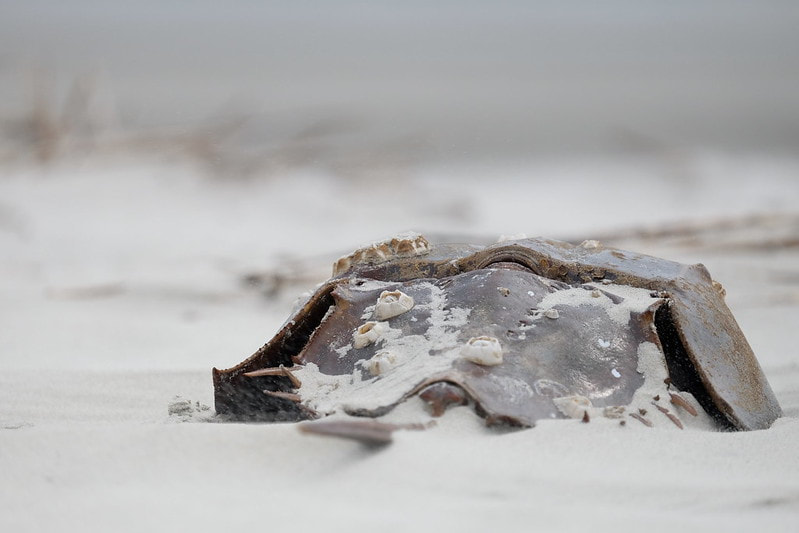|
By Liza Casella There are exactly zero counties in the United States where one can support a family on a minimum wage salary. In 2018, 8.5% of Americans, including 5.5% of children, did not have health insurance. Economic mobility is becoming increasingly difficult. It is blatantly obvious that capitalism in the United States is propagating cycles of poverty, exploiting low-income families, preventing people from accessing preventative and emergency healthcare, and is thus indirectly responsible for the death of millions. A lesser known victim of capitalism is the horseshoe crab. Unlike most crabs, horseshoe crabs are not actually crustaceans. They are members of the phylum Arthropoda, along with spiders and scorpions. Arthropods are defined by their segmented bodies, paired and jointed appendages, and a cuticle, which is a type of exoskeleton made of chitin, a nitrogen-containing polysaccharide. Horseshoe crabs, as they are in their present form, have existed for at least 250 million years, and fossils of horseshoe crabs have been found dating back 500 million years. As the shallow seas of the Mesozoic era disappeared and the European land mass formed, horseshoe crabs migrated from Europe to the coasts of East Asia and to the Atlantic coastline along the United States and Mexico. The latter type is Limulus polyphemus, the American horseshoe crab. They range in size: females measure 18-19 inches from head to tail, and males 13-14 inches.
For many years, horseshoe crabs were considered a “trash fish” (a real term), and their shells were ground up to make fertilizer. But in 1971, everything changed. Scientists discovered that when exposed to E. coli, a horseshoe crab’s blood formed clots. This discovery had a huge effect on the biomedical and pharmaceutical industries. Horseshoe crabs have bright blue blood. Their blood is bright blue because it contains hemocyanin. We have the iron-containing oxygen-transport protein hemoglobin in our blood, but horseshoe crabs and many other arthropods have the copper-containing analog hemocyanin. When a hemocyanin molecule binds a molecule of oxygen, its two copper atoms are oxygenated, and it turns bright blue. The horseshoe crab’s bright blue blood contains Limulus Amebocyte Lysate (LAL), a clotting factor that binds bacterial endotoxins (the lipopolysaccharides of gram-negative bacteria), forming a blood clot around the pathogen and protecting the horseshoe crab from infection. Through exposing pharmaceuticals and medical devices to LAL, it is possible to detect bacterial contamination. The LAL test was officially introduced in the 1970s, and has since become the standard test for screening pharmaceuticals and medical devices for contamination. The LAL testing industry is worth $50 million annually, and 25% of the medical device market alone is dependent on LAL tests. Every injectable drug is tested with LAL. This is bad news for the horseshoe crabs. 250,000 horseshoe crabs are captured annually to harvest LAL. About 30% of their blood is drained, and then they are released back into the ocean. According to the biomedical industry, this practice is safe, and, once returned to the ocean, the crabs continue on with their lives as if they had not just lost almost a third of their blood. For reference, humans have approximately 1.2-1.5 gallons of blood in our bodies. One third of that is 3.6 pints, or 3.6 times the amount of blood we’re allowed to donate at one time. In actuality, this practice is not safe for the horseshoe crabs, and 10-30% of them die as a result of losing so much blood. The crabs that do survive are also at a disadvantage once they are back in the ocean. One study showed that these female crabs move significantly more slowly, have decreased activity levels, and exhibit dysregulated circadian rhythms. This loss of fitness lessens the horseshoe crabs’ ability to perform their mating ritual, in which the crabs crawl to the beach under the full moon, with the males holding on to the females because they are too small and weak to move against the tide. As a result, the females’ loss of fitness leads to population decline. In addition, shore birds that rely on horseshoe crab eggs for food are also experiencing population decline, a cycle which disrupts the entire ecosystem. So what can be done? There are few restrictions on how many horseshoe crabs the biomedical industry is allowed to catch. In Massachusetts, for example, the only regulations state that no more than 1000 crabs per day can be harvested for biomedical research, and they can be harvested anywhere along the coast except in national wildlife reserves. Some argue that being used for LAL tests is beneficial to the crabs. Because they are only allowed to be caught for the purpose of harvesting their blood, they are protected from being ground up for fertilizer, which is significantly more fatal. But both of these practices lead to crab death and population decline. Luckily, there exists a synthetic compound, called recombinant Factor C (rFC), which is equally as effective as LAL for detecting bacterial contamination. It is estimated that the use of rFC instead of LAL could reduce the use of horseshoe crab blood in the biomedical industry by 90%. Unluckily, rFC is expensive to manufacture, so companies are not inclined to use it when horseshoe crabs are a cheaper alternative. The sad reality is that horseshoe crabs are dying because their blood is being used in the biomedical industry, and they would die from being used in the fertilizer industry. Their death is causing the destruction of ecosystems along the Atlantic coastline. And, while there is an effective alternative to harvesting their blood, it is unpopular and rarely used due to its cost. Capitalism is killing the horseshoe crabs.
1 Comment
Anthony J, Casella, Esq.
5/25/2021 06:44:10 pm
Very interesting,informative and well researched,
Reply
Leave a Reply. |
Categories
All
Archives
April 2024
|

